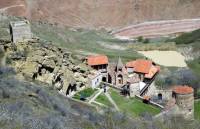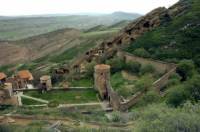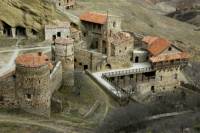David Gareji
David Gareji is located in Eastern Georgia, 25 km from Tbilisi, on Iori plateau near the border of Georgia and Azerbaijan. It includes the complex of 19 Medieval monasteries with approximately 5 000 cells for monks.
David Gareji is one of the most important landmarks of Georgia. This site is characterised by a unique combination of historic architecture, prehistoric archaeological sites, rich palaeonthological fields and important bio-geographical features widely spread within the arid and semiarid landscape of the river Iori plateau. The dozens of cave monasteries decorated with unique frescoes are the best examples of harmonious interaction of man made structures with the dramatic landscape. They bear the traditional principles of sustainable living and are considered as the masterpieces of Georgian Medieval art.
The archaeological excavations have revealed the remains of Acheulian, Mousterian, Kura-Araxes, and Trialeti cultures. Urban-type settlements of the Late Bronze and Iron Ages have also been discovered. After a gap in the classical period, significant archaeological material has come to light on Medieval sites, notably in the monasteries of the desert.
The foundation of monastic centre in the first half of 6th century in the Gareji desert is connected with the name of one of the 13 Assyrian Fathers, St. David named Garejeli and his disciples Lukiane, Dodo and others. Along with the Lavra founded by St. David Garejeli, they laid the foundation of the monasteries of Virgin (Dodos Rka) and St. John the Baptist (Natlismtsemeli).
In Medieval times, Gareji desert with its rock-cut monasteries and magnificent murals containing the portraits of Georgian Kings, served as one of the most important monastic and pilgrimage centres of Georgia. It was a Royal monastery with a primary and figurative meaning. The Kings themselves patronised and took care of it.
In addition to churches, chapels and cells, there were numerous caves at Gareji for practical, everyday purposes; caves which served as barns, bakeries, smithies and housing for livestock. Terraces were constructed for agricultural purposes.
Some unique mural paintings are preserved in the Gareji monasteries, the oldest of which go back to the 8th century. Analysis of the surviving remains leads to the conclusion that till the end of the 10th century they only partially painted the interiors of Churches: usually just the apse and dome, but sometimes the northern wall as well. The most ancient mural paintings are found in the Dodos Rka Monastery, on an apse of one of the small Churches. Mural paintings of the 10th century are to be found in the Tsamebuli and Udabno Monasteries.
The period between the end of 10th to the beginning of 13th centuries was a golden age of Gareji monasteries. The Gareji School of painting developed in this period. One of the main features of this School is the representation of episodes from the life of St. David Garejeli in addition to the canonical scenes. The oldest example is to be found in the first layer of paintings of the main Church chapel of the Udabno Monastery. Another feature of the Gareji school of painting is an abundance of contemporary and realistic portraits of Royal personages. In some cases, they are the only images to have survived.
The turn of the 12th and 13th centuries witnessed the creation of the mural paintings of Bertubani Monastery, the finest achievement of the Gareji School. They are very impressive free style works and are distinguished by complete renditions of Life of the Virgin Mary.
Paintings of the small Annunciation Church in the Udabno Monastery date to the second half of the 13th century. An unknown artist inspired by the Bertubani paintings created murals of the Annunciation in the canonical manner and in a similarly free style; the colours, however, are darker.
The Mongol invasions of the first half of the 13th century brought monastic life at Gareji to an end for the time being. New mural paintings were not to be made until the 17th and 18th centuries, when serious attempt were made to revive monastic life, albeit on a small scale.
David Gareji area as a distinguished sacred site and a prominent monument of cultural heritage has never lost its importance. The historical value of David Gareji deserts monastic complex as well as uniqueness of biodiversity of its site still remains a reason for the urgent need for their care.










